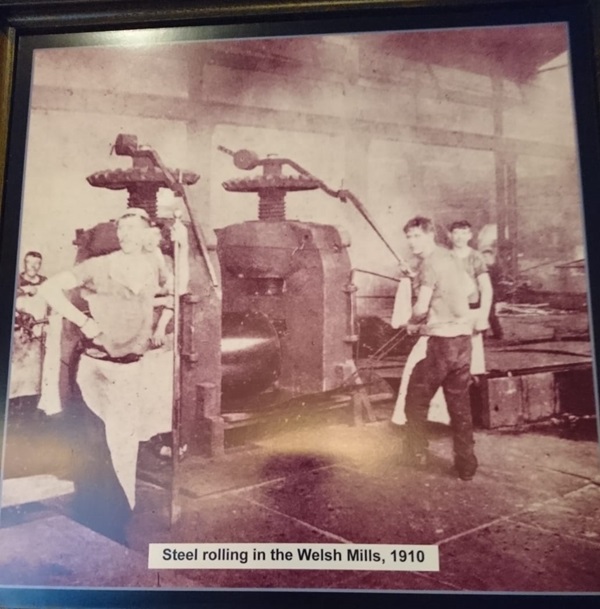Pub history
The Central Hotel
This distinctive building has been a local landmark for many years. It stands on what was marshland, alongside the River Dee, which covered much of the area of the present town. The Central Hotel was built in c1920, next to the railway station and the bridge over the main road. In 1922, a ‘Mr Derbyshire’ was recorded as its landlord. In the mid 1980s, the hotel was renamed The Royal Charter, yet later reverted to its original name.

2–4 Chester Road West, Shotton, Flintshire, CH5 1BX
This distinctive building has been a local landmark for many years. It stands on what was marshland, alongside the River Dee, which covered much of the area of the present town. The Central Hotel was built in c1920, next to the railway station and the bridge over the main road. In 1922, a ‘Mr Derbyshire’ was recorded as its landlord. In the mid 1980s, the hotel was renamed The Royal Charter, yet later reverted to its original name.
Text about The Central Hotel.

The text reads: The distinctive three storey building that you are now in has been a local landmark for nearly a century. The Central Hotel has been on this site, next to Shotton station and the railway bridge over the main road, since c1920.
A “Mr Derbyshire” was recorded as the landlord in 1922. A “Mr Derbyshire” also ran the public house in the 1940s. In the mid-1980s, the Central Hotel was renamed the Royal Charter, but reverted to its original name ten years later.
The site of the Central Hotel, and the adjoining railway station, was originally marshland. By the 1880s the marshlands had been turned into fertile fields, covering the area between Chester Road West and the banks of the River Dee.
Above: The view from the railway bridge looking west towards Connah’s Quay, c1920. The site of the Central Hotel, which was just being built at this time, is on the right.
Text about the iron and steel industry.

The text reads: For more than a century the name of Shotton has been associated with iron and steel. The John Summers & Sons Ironworks opened in 1896, initially employing around 250 men.
Steel produced by John Summers & Sons was ferried from the company’s Shotton wharf to sea-going ships in Liverpool. Summers’ ships were known locally as ‘The Beetle Fleet’. The first two steamers were built in 1897 and named Buffalo and Rio Formosa.
A photograph and text about Hawarden Castle.

The text reads: Originally known as Broadlane Hall, this grand residence was rebuilt in the 1750s by Sir John Glynne. The house forms the basis of the modern building, which was enlarged and encased in stone in 1809-10.
The work was carried out for Sir Stephen Richard Glynne, who renamed it Hawarden (pronounced harden) Castle. Sir Stephen’s daughter married William Ewart Gladstone, who served four terms as prime minister. It was their marital home until Gladstone’s death in 1898.
Hawarden Old Castle stands in its grounds. The castle played an important role in the Welsh struggle for independence in the 13th century. After the Civil War in the mid 17th century Hawarden Castle was slighted on the orders of Oliver Cromwell.
Left: Felling trees at Hawarden. This was Gladstone’s favourite hobby (he is standing far right).
A photograph and text about the history of Shotton.

The text reads: The history of Shotton dates back more than 1,000 years. Its name derives from the Saxon words ‘shot’, a clearing or glade in the wood, and ‘tun’, an enclosure or farmstead. Shotton is interpreted as meaning ‘farmstead in the glade’.
The ‘farmstead’ probably refers to Killins Farm, which still exists today. The original hamlet of Shotton was situated at the junction of Shotton Lane and Killins Lane.
The manor house, known as Shotton Hall, stood on a half-acre plot between Gladstone Street and Plymouth Street. It was built in the early 17th century and is said to have been the birthplace of the first earl of Plymouth. Shotton Hall was demolished in 1922, to make way for housing.
A photograph of galvanised sheets being patent flattened, 1910.
An aerial photograph of the works in the 1920s.
A collection of photographs including Hawarden Village and Hawarden Castle.
A photograph of operators in the control pulpit of the hot mill finishing train, 1949.
A photograph of tapping an open heath furnace, 1910.
A photograph of Mr and Mrs Gladstone and their family at Hawarden.
A photograph of steel rolling in the Welsh Mills, 1910.
A photograph of the Old Castle, Hawarden.
A photograph of the men of No. 1 Steelworks, 1906.
A photograph of the high sheet mills, 1931.
A photograph of Shotton Hall, c1910.
External photograph of the building – main entrance.















